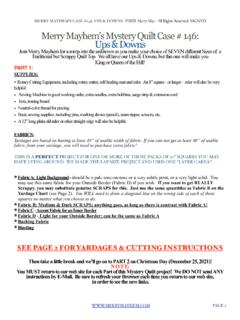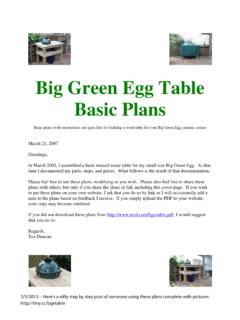Transcription of Original Recipe - Quilting Digest
1 Original Recipe can be found at Original Recipe Clermont Farms Quilted Tote Bag by Glenn Dragone This Americana themed, multipurpose tote is suitable for the pool, the green market, or a fun day trip. 1 Clermont Farms Jelly Roll by Minick & Simpson 1 yard Clermont Farms solid navy 1 yard cotton batting Front Panel Step 1: Cut Squares 2 x 2 Choose four strips of fabric from the jelly roll. I used the dark blue paisley, the white and blue tossed plums, the blue with white sprays of flowers, and the dark blue lattice with roses.
2 The fabric width is Original Recipe can be found at already 2 , so simply lay out each strip on your cutting board, measure out 2 across the length, and cut away. Using my patterns, cut 12 squares of the dark blue paisley, 12 squares of the white and blue tossed plums, 6 squares of the blue with white sprays of flowers, and 6 squares of the dark blue lattice with roses. Step 2: Layout Your Panel Step 3: Sew the Squares Together Sew right sides of two squares together using a seam allowance. You can chain piece if you like. Use a dry iron or finger press your seam allowances to the darker side.
3 Keep the layout photo as a handy reminder. Sometimes distractions come up and those tiny squares get jumbled up. Now sew the completed set of two squares into blocks of four. Make sure your seams interlock. I rub my fingers together over the joining seam prior to sewing. If they are locked in, you will be able to feel a smooth connection. Gently pull the two pieces apart to see if the join is locked. The locked joins will yield a sharp intersecting point on the face. Again press the seams to one side after finishing. Join the three sets of blocks across into three rows.
4 Press the seams to one side for each row. Original Recipe can be found at Finally, join the three rows together. It is a good idea to pin the joins for the final row of sewing to keep the intersections aligned. Voila! The Front Panel is complete. Step 4: Add a Border Measure the length of the left side of your panel (mine was 12 ), and cut a solid red strip from the jelly roll the same size. Now cut the strip in half lengthwise. I ended up with two strips measuring 12 x 1 . With right sides together, sew the left and right borders to your panel.
5 Now repeat these steps for the top and bottom borders of your panel. Original Recipe can be found at Back Panel Repeat the steps for the front panel to create your back panel. I chose different fabrics, and used the lighter blue paisley, the white and blue tossed miniatures, the light blue and white rose, the lighter blue lattice with roses, and solid cream for the border. Cut 12 squares of the paisley, 12 squares of the miniatures, 6 squares of the roses, and 6 squares of the lattice. Here is the layout for the Back Panel. Side Panels Measure the sides of your front and back panels.
6 They should be approximately the same size, but no worries if they are a bit off, we are going to trim the pieces before construction. For each side, choose four strips of fabric from the jelly roll, and cut to the larger measurement (better too big than too small). The fabrics I chose are pictured. Straight stitch these four strips together to create the side panel. Repeat these steps to create your second side panel. I chose to use the red paisley and the tossed plum on beige for both. The variation is in the colors of the blue and white roses and lattice with roses.
7 In one panel I used the lighter blue and in the other the darker. Side Panel One Side Panel Two Original Recipe can be found at Bottom Panel Measure the bottom of your front and back panels. Choose four strips of fabric, cut to the larger measurement, and straight stitch together. Pictured are my selections. Quilting Now the fun begins! We are going to treat each of the five panels as if they are mini quilts. Cut a piece of the 1 yard of solid navy so that it is 1 larger on all sides of your first panel to be quilted.
8 Then cut a piece of cotton batting the same size. Make a quilt sandwich by positioning your solid navy face down on your mat, followed by the batting and the panel face up. Secure your sandwich with pins. Quilt your panel, as you like. I used a simple stitch in the ditch approach with each panel. Sandwich and quilt the rest of your panels. After you finish Quilting , trim up each panel. This is the point where you can ensure the pieces are all the same size. Binding Decide which edge you would like to be the top of your front, back, and side panels because we are about to give them a nice finish.
9 Measure the top of the panel you are working on and cut a piece of solid navy to fit its width. My first panel measured 13 , so I cut a strip 13 x 2 . Now press that strip in half, and sew the raw edge to the raw edge of the panel like a quilt binding. After adding the binding, turn the strip and hand stitch binding to the back lining. Original Recipe can be found at Repeat for the three remaining panels. The bottom panel does not need to be bound because it will be sewn to the body of the tote bag on all four sides. Handles Cut two strips of solid navy to 21 x 4.
10 This will yield a handle approximately 8 in height from the top of the bag. Fold each strip in half lengthwise and press. Open up each strip and fold the sides to meet in the middle. The pressed fold will help to gauge the center. Cut two strips of batting to 21 x 1 and tuck it inside flush against one side. Sew the open side closed. To keep it balanced in appearance, sew another line down the opposite side. Measure 3 from each end of the top front and top back panels. Pin the handle so the end of the handle meets the bottom of the solid border. Make sure the handles are not twisted prior to sewing.







